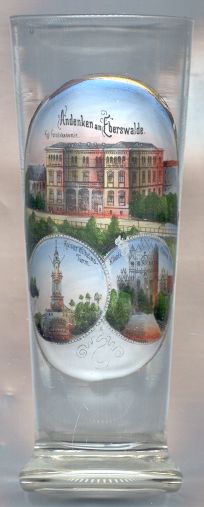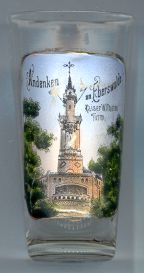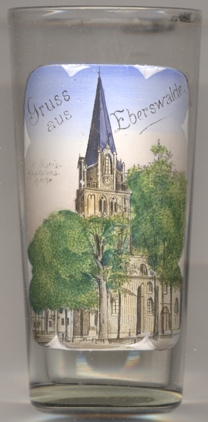

|
| DEUTSCHLAND | GERMANY |
| Bundesland: Brandenburg | |
| Landkreis: Barnim |
Eberswalde is situated at an elevation of 59 m at the river Finow in northern Brandenburg. Everswolde was first mentioned in a document of 1276 and obtained the status of a market town in 1300. Between 1375 and 1877 the common name of the town was Neustadt or Neustadt-Eberswalde. The first Finow canal was built between 1605 and 1620, but was destroyed during the Thirty Years' war (1618–1848). The second Finow canal, connecting the rivers Havel and Oder, was completed in 1746 and became the most important factor for the economical development of the whole region. The railroad from Berlin via Eberswalde to Stettin (now Szczecin, PL) was opened in 1842. The new Hohenzollernkanal (today Oder-Havel-Kanal) was opened in 1914. In 1945 one third of the old town was destroyed. The towns of Eberswalde and Finow were merged in 1970 under the new name Eberswalde-Finow. On 1 July 1993 the name of the municipality was changed again to Eberswalde. The communities Sommerfelde and Tornow were incorporated into Eberswalde in December of the same year. At he same occasion, the former districts Eberswalde and Bernau were merged to become the newly-formed district Barnim, which also includes the communities Hohensaaten and Tiefensee of the former district Bad Freienwalde. The seat of the district's administration is in Eberswalde.
 The former
The former  Königliche Forstakademie (Royal Forest Academy) [left, no. 1262: top picture]
was opened in 1830, after the academy had been transferred to Eberswalde from Berlin.
The (new) building was erected in 1873–1876 in Neo-Renaissance style. From 1946 until its closure in 1963 it was a faculty of the
Humboldt-University of Berlin. Today, the building is used as the seat of the German Entomological Institute.
In 1992, the Eberswalde University of Applied Sciences continued the tradition of the old forest academy.
Königliche Forstakademie (Royal Forest Academy) [left, no. 1262: top picture]
was opened in 1830, after the academy had been transferred to Eberswalde from Berlin.
The (new) building was erected in 1873–1876 in Neo-Renaissance style. From 1946 until its closure in 1963 it was a faculty of the
Humboldt-University of Berlin. Today, the building is used as the seat of the German Entomological Institute.
In 1992, the Eberswalde University of Applied Sciences continued the tradition of the old forest academy.
The  former monastery Chorin [left, no. 1262: bottom right picture] is one of the best-known sights in the whole Barnim district.
The former Cistercian monastery was founded by the margraves Otto III and Johann I. The original location of the monastery Mariensee
was a small island in the lake Parsteiner See. In 1273 the monastery was transferred to Chorin. The buildings of the monastery were completed in 1334.
During the Middle Ages, up to 280 monks lived here, but eventually, in 1542, the monastery was closed and the buildings were then used as agricultural facilities.
During the Thirty Years' War, the former monastery was heavily damaged; parts of the complex were then torn down after the times of war.
The Prussian forest administration acquired the old monastery buildings in 1861. Although only parts of the former monastery have survived until today,
the remaining parts are some of the oldest and most important brickwork buildings of the early Gothic period in Germany.
Since 1960, the ruins of the monastery are used also for music performances (Choriner Musiksommer).
former monastery Chorin [left, no. 1262: bottom right picture] is one of the best-known sights in the whole Barnim district.
The former Cistercian monastery was founded by the margraves Otto III and Johann I. The original location of the monastery Mariensee
was a small island in the lake Parsteiner See. In 1273 the monastery was transferred to Chorin. The buildings of the monastery were completed in 1334.
During the Middle Ages, up to 280 monks lived here, but eventually, in 1542, the monastery was closed and the buildings were then used as agricultural facilities.
During the Thirty Years' War, the former monastery was heavily damaged; parts of the complex were then torn down after the times of war.
The Prussian forest administration acquired the old monastery buildings in 1861. Although only parts of the former monastery have survived until today,
the remaining parts are some of the oldest and most important brickwork buildings of the early Gothic period in Germany.
Since 1960, the ruins of the monastery are used also for music performances (Choriner Musiksommer).
 The picture on the bottom left of glass no. 1262 [far left] and the picture on glass no. 1321 [near left]
shows the
The picture on the bottom left of glass no. 1262 [far left] and the picture on glass no. 1321 [near left]
shows the  Kaiser-Wilhelms-Turm, erected in memory of Emperor Wilhelm I,
the first emperor of Germany (r.1871–1888). The lookout tower was inaugurated in 1896 and had a height of 54 m.
It was located to the south of Eberswalde in the Oberheide heath and was destroyed in 1945.
Kaiser-Wilhelms-Turm, erected in memory of Emperor Wilhelm I,
the first emperor of Germany (r.1871–1888). The lookout tower was inaugurated in 1896 and had a height of 54 m.
It was located to the south of Eberswalde in the Oberheide heath and was destroyed in 1945.
Several glasses of this collection show other monuments for Wilhelm I.
 The
The  Maria-Magdalenen-Kirche [near left, no. 4160] was built in the first third of the
14th century, about after 1433. After the great fire of 1499, major modifications to the structure were made in 1503. Further additions
followed in 1726. After the Reformation came to the area in 1539, the first Protestant service in this church was celebrated in 1542. Following his
death in the battle of Lützen in 1632 during the Thirty Years' War (1618–1648), Swedish King Gustav II Adolf was laid out
in this church during the transfer of the body to Sweden. A major restoration of the church was carried out in 1876, the interior was throughly
renovated in 1977, the exterior parts were renovated in 1993.
Maria-Magdalenen-Kirche [near left, no. 4160] was built in the first third of the
14th century, about after 1433. After the great fire of 1499, major modifications to the structure were made in 1503. Further additions
followed in 1726. After the Reformation came to the area in 1539, the first Protestant service in this church was celebrated in 1542. Following his
death in the battle of Lützen in 1632 during the Thirty Years' War (1618–1648), Swedish King Gustav II Adolf was laid out
in this church during the transfer of the body to Sweden. A major restoration of the church was carried out in 1876, the interior was throughly
renovated in 1977, the exterior parts were renovated in 1993.
[https://de.wikipedia.org/wiki/Maria-Magdalenen-Kirche_(Eberswalde)]
![[scale]](lineal.jpg)